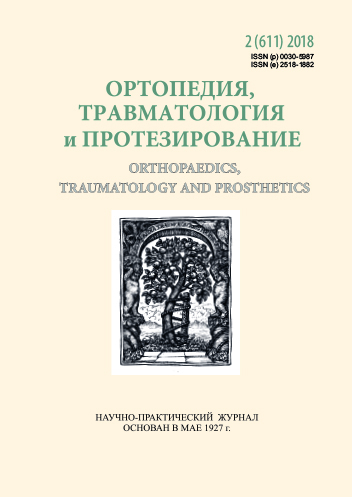Functional spine analysis at surgical treatment of burst fractures of thoracic and lumbar spine
DOI:
https://doi.org/10.15674/0030-5987201825-12Keywords:
vertebrae segment trauma, local kyphotic deformity, spine-pelvic balance, surgical treatmentAbstract
Burst fracture — is traumatic injury under the influence of high-energy axial compression which results multifragmentary vertebrae fracture with penetration of bone fragments into spine canal and paravertebral tissues.
Objective: to analyze the magnitude of kyphotic deformity and indexes of sagittal spine balance after surgical treatment of burst fractures.
Methods: retrospective study was made of 99 case histories. Criteria of inclusion were: incomplete burst (type А3.1) and incomplete split burst fracture (А3.2), complete burst fracture (type А3.3), vertebrae body with destruction (АВ) and rotation (АС). All patients were divided into 4 groups: I (17 patients) — transpedicular fixation with six screws; II (55) — posterior fixation with eight screws; III (22) — anterior-posterior combined spinal 360° fusion; IV (5) — tree column reconstruction from posterior approach.
Results: fixation with six screws was used mostly in patients with type A3.1 fractures, it allowed us to correct kyphotic deformity in average 8.4º ± 6.5º and provide stable osteosynthesis. In patients of II group the magnitude of kyphotic deformity after trauma was 16.4º ± 6.9º, the average magnitude of its correction was 12.6º ± 7.0º. In the III group of patients this index was 18.3º ± 9.7º, and in the IV — 18.67º ± 2.08º.
Conclusions: The choice of method of fixation depends on the morphology of injury. Totally surgical treatment of burst fractures can provide preservation of sagittal vertical axis. Usage of eight screws fixation and combined anterior and posterior spine 360° fusion is the most effective for deformity correction.References
- Radchenko, V. O., Popsuyshapka, K. O., Babalyan, Yu. O., & Teslenko, S.O. (2017). Burst fractures of the thoracic and lumbar spine (part one). Ukrainian neurosurgical journal, 4, 10–17. doi: https://doi.org/10.25305/unj.111352 (in Ukrainian)
- Radchenko, V. O., Popsuyshapka, K.O., Babalyan, Yu. O., & Teslenko, S.O. (2018). Burst fractures of the thoracic and lumbar spine (part two). Ukrainian neurosurgical journal, 1, 19–27. doi: https://doi.org/10.25305/unj.113533 (in Ukrainian)
- Aebi, M., Arlet, V., & Webb, J. (2007). AO spine manual principles and techniques. Thieme, 1, 663.
- Aebi, M., Arlet, V., & Webb, J. (2007). AO spine manual principles and techniques. Thieme, 2, 837.
- Dai, L. Y., Jiang, L. S., & Jiang, S. D. (2008). Conservative treatment of thoracolumbar burst fractures a long-term follow-up results with special reference to the load sharing classification. Spine, 33(23), 2536–2544. doi: https://doi.org/10.1097/BRS.0b013e3181851bc2
- Joaquim, A. F., Fernandes, Y. B., Cavalcante, R. A., Fragoso, R. M., Honorato, D. C., & Patel, A. A. (2011). Evaluation of the thoracolumbar injury classification system in thoracic and lumbar spinal trauma. Spine, 36(1), 33-36. doi:https://doi.org/10.1097/brs.0b013e3181c95047
- Vaccaro, A. R., Rihn, J. A., Saravanja, D., Anderson, D. G., Hilibrand, A. S., Albert, T. J., … Fisher, C. (2009). Injury of the posterior ligamentous complex of the thoracolumbar spine. Spine, 34(23), E841-E847. doi:https://doi.org/10.1097/brs.0b013e3181bd11be
- Jackson, R. P., & McManus, A. C. (1994). Radiographic analysis of sagittal plane alignment and balance in standing volunteers and patients with low back pain matched for age, sex, and size. Spine, 19(Supplement), 1611-1618. doi:https://doi.org/10.1097/00007632-199407001-00010
- Keynan, O., Fisher, C. G., Vaccaro, A., Fehlings, M. G., Oner, F. C., Dietz, J., … Dvorak, M. (2006). Radiographic measurement parameters in thoracolumbar fractures: a systematic review and consensus statement of the Spine Trauma Study Group. Spine, 31(5), E156-E165. doi:https://doi.org/10.1097/01.brs.0000201261.94907.0d
- Schwab, F., Ungar, B., Blondel, B., Buchowski, J., Coe, J., Deinlein, D., … Lafage, V. (2012). Scoliosis research society—Schwab adult spinal deformity classification. Spine, 37(12), 1077-1082. doi:https://doi.org/10.1097/brs.0b013e31823e15e2
- Altay, M., Ozkurt, B., Aktekin, C. N., Ozturk, A. M., Dogan, Ö., & Tabak, A. Y. (2007). Treatment of unstable thoracolumbar junction burst fractures with short- or long-segment posterior fixation in magerl type a fractures. European Spine Journal, 16(8), 1145-1155. doi: https://doi.org/10.1007/s00586-007-0310-5
Downloads
How to Cite
Issue
Section
License
Copyright (c) 2018 Volodymyr Radchenko, Konstantin Popsuishapka, Sergii Teslenko

This work is licensed under a Creative Commons Attribution 4.0 International License.
The authors retain the right of authorship of their manuscript and pass the journal the right of the first publication of this article, which automatically become available from the date of publication under the terms of Creative Commons Attribution License, which allows others to freely distribute the published manuscript with mandatory linking to authors of the original research and the first publication of this one in this journal.
Authors have the right to enter into a separate supplemental agreement on the additional non-exclusive distribution of manuscript in the form in which it was published by the journal (i.e. to put work in electronic storage of an institution or publish as a part of the book) while maintaining the reference to the first publication of the manuscript in this journal.
The editorial policy of the journal allows authors and encourages manuscript accommodation online (i.e. in storage of an institution or on the personal websites) as before submission of the manuscript to the editorial office, and during its editorial processing because it contributes to productive scientific discussion and positively affects the efficiency and dynamics of the published manuscript citation (see The Effect of Open Access).














